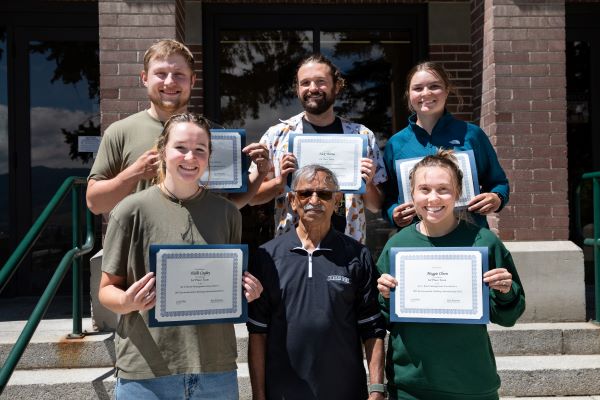Montana Tech students bring home first place from Air and Waste Management Association’s Environmental Challenge International (ECi) Competition

Montana Technological University students took home first place at the Air and Waste Management Association’s Environmental Challenge International (ECi) Competition held June 9-12, 2025 in Raleigh, North Carolina.
Montana Tech’s team consisted of environmental engineering graduate students Meggie Olson, of Evergreen, Colorado; Madison Skeel of Butte, Montana; Gavin Rahl of Stevensville, Montana; Halle Cogley, of Challis, Idaho; and Nick Thieme from Ottawa, Illinois. Their faculty leader is Environmental Engineering Department Head Dr. Kumar Ganesan.
The team competed against California Polytechnic State University, Louisiana State University, and the University of Cincinnati. The students were asked to come up with a creative way to remove per- and polyfluoroalkyl substances (PFAS) from drinking water at suitable scales for existing treatment facilities within North Carolina. Often referred to as “forever chemicals” PFAS chemicals are manmade substances found in a number of products including non-stick cookware, stain-resistant carpet and furniture, waterproof clothing, firefighting foam, refrigerants, artificial turf, building materials, and more. In April 2024, the Environmental Protection Agency released the first-ever, national, legally enforceable drinking water standard for PFAS. It is anticipated that the standard will be fully enforceable in 2029.
“What’s cool is this is a real-world issue,” Olson said. “They don't have solutions for it yet. They're kind of grasping for things to fix it right now.”
“PFAS can cause health issues, they cause immunosuppression and certain types of cancer,” Cogley said. “This is a big problem. It’s an emerging contaminant.”
The team made sure to bring a unique approach to the problem.
“We looked at solutions from a different angle than the traditional methodologies used for treating PFAS in drinking water,” Rahl said. “We looked at some technologies that have been used in other forms and medias. We landed on biochar. Our solution used activated biochar as a filter.”
Biochar resembles charcoal, and is the substance left over after biomass has been burned. It is a common soil amendment, is light weight, and is a renewable/natural resource. Montana Tech’s team found a type of activated biochar that is very effective at removing PFAS chemicals. Though the competition does not require the team to implement their plan, the team sees opportunities to take what they learned and apply it in the field.
Thieme highlighted the importance of learning about ways different strategies of PFAS mitigation could be deployed in different parts of the country. North Carolina has hurricanes, whereas Montana does not. Hurricanes often leave behind urban lumber that needs to be disposed of.
“That's something we incorporated in our design,” Thieme said. “Instead of having that lumber go to the landfill, we would reuse it to make biochar.”
Skeel said she enjoyed learning about how the University of Buffalo is studying a strain of bacteria that can eat forever chemicals and toxic byproducts.
“The bacteria degrade the PFAS chemicals so they are no longer in existence,” Skeel said.
Dr. Ganesan says he’s looking at PFAS levels are of concern in Montana, so the Environmental Engineering Department might be able to research ways to help impacted communities in Montana and beyond.